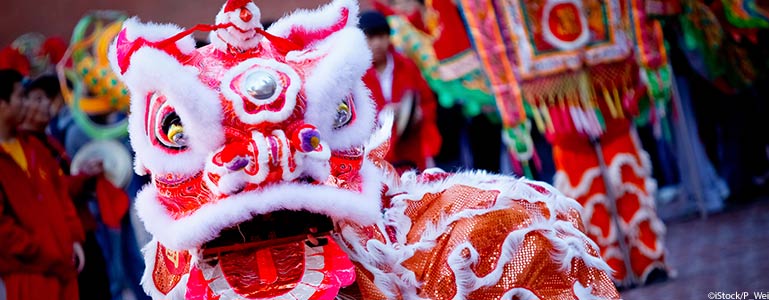Around the world, people who live in the Northern Hemisphere celebrate the mid-point between the Winter Solstice and the Spring Equinox. In countries that use lunar calendars to determine festival days (many of which are in Asia and the Middle East), this signals the beginning of the new year and the first stirrings of spring.
There are lots of ways to honor and celebrate various midwinter traditions that are delightful, educational and bring families together.
The Chinese Lunar New Year begins on February 8th this year, and marks the beginning of the Chinese year 4714. The Chinese Lunar New Year traditionally begins at the first new moon after January 21st. Each year is said to be represented by one of 12 animals in the Chinese Zodiac. This coming year is the Year of the Monkey.
In San Francisco, we are extremely fortunate to be host to the largest Chinese New Year Parade outside Asia. The parade is free to watch, and features more than 100 groups, including extravagant lion dancers and a 200-foot-long Golden Dragon. San Francisco’s Chinatown offers numerous other events and activities throughout the two-week New Years celebration, many of which are free, such as lion dance exhibits, and craft activities like making lucky red envelopes, at city libraries.
There are many crafts you can make at home to celebrate the Chinese New Year. Try making a paper dragon or Chinese drum noisemakers, or baking your own fortune cookies. (If you’re in San Francisco, be sure to visit the Golden Gate Fortune Cookie Factory, to see how the pros bake and fold the famous cookies.)
The Jewish holiday Tu B’Shevat, which occurs in mid-winter in the Northern Hemisphere (sundown, January 24th, this year) is known as the New Year of the Trees and, in some circles, the Jewish Earth Day. Its date coincides with the earliest blooming trees in Israel and it is celebrated by planting trees and plants and by eating tree fruits and nuts. For our family, celebrating Tu B’Shevat represents a way to honor the turning of the year, welcome the promise of spring and new life, and recommit to caring for the nature around us.
Looking for a meaningful way to celebrate Tu B’Shevat? Consider planting a tree or seeds, or choosing a natural area to steward by weeding or picking up trash. Take a nature walk and observe what you see, or make a homemade bird feeder, so you can help the birds at a point in winter when much of their food supply has diminished.
In the U.S., Groundhog Day, February 2nd, is a well-known midwinter holiday, in which it is said that a groundhog rises from his underground burrow to predict a long or short winter, based on whether or not he produces a shadow. The holiday has its roots in Candlemas Day, originally a Medieval Catholic holiday to mark the mid-point between the Winter Solstice and the Spring Equinox in the Northern Hemisphere. (The Celtic-Gaelic St. Brigid’s Day, a time of festivals, feasting and parades, which is still celebrated widely in Ireland, is another precursor to Groundhog Day.)
Pennsylvania’s German settlers believed that if the weather was fair on Candlemas Day (causing the groundhog to see his shadow), then the second half of winter would be stormy and cold, producing “six more weeks of winter.” This site explains the science of Groundhog Day and the fact that cloudy weather is actually milder than clear, cold weather. Groundhog Day was first celebrated in the U.S. in 1886 and featured a groundhog named “Punxsutawney Phil” , the same name of the groundhog that makes predictions today.
To celebrate Groundhog Day, try making hand shadow puppets, having a friend trace your shadow, or enjoying one of these shadow-themed activities or weather experiments.
Enjoy your celebration of midwinter. Hopefully it won’t feel like too long a wait until spring.
Susan Sachs Lipman (Suz) is the author of Fed Up with Frenzy: Slow Parenting in a Fast-Moving World, which contains 300+ activities for family fun and grew out of her blog, Slow Family Online. Slow Parenting and the book were named a 2012 Top 10 Parenting Trend by TIME Magazine. Suz has written for the New York Times’ Motherlode blog, the Christian Science Monitor’s Modern Parenthood blog, and many others. She is the Social Media Manager for JFCS and Parents Place.



